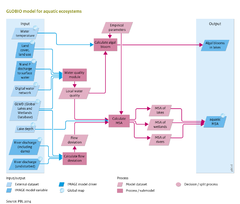Aquatic biodiversity: Difference between revisions
Jump to navigation
Jump to search
No edit summary |
No edit summary |
||
| Line 7: | Line 7: | ||
The [[GLOBIO model]] for aquatic ecosystems, GLOBIO aquatic, is based on a catchment approach to account for the composite effect of pressure factors on various parts of a catchment. The main drivers included are land use and nutrient loss within catchments, water flow deviations, and climate change. Changes in these drivers in future scenarios as calculated by the IMAGE model are used as input to GLOBIO aquatic. | The [[GLOBIO model]] for aquatic ecosystems, GLOBIO aquatic, is based on a catchment approach to account for the composite effect of pressure factors on various parts of a catchment. The main drivers included are land use and nutrient loss within catchments, water flow deviations, and climate change. Changes in these drivers in future scenarios as calculated by the IMAGE model are used as input to GLOBIO aquatic. | ||
The biodiversity indicators are comparable with those in the GLOBIO model for terrestrial ecosystems: species richness and biodiversity intactness, which is the mean abundance of original species relative to their abundance in undisturbed ecosystems ( | The biodiversity indicators are comparable with those in the GLOBIO model for terrestrial ecosystems: species richness and biodiversity intactness, which is the mean abundance of original species relative to their abundance in undisturbed ecosystems ({{abbrTemplate|MSA}}). Similar to its terrestrial counterpart, the driver-impact-relationships for aquatic biodiversity are based on meta-analyses of empirical data from the literature. In addition to biodiversity indicators, the model calculates the occurrence of harmful algal blooms in lakes. | ||
Revision as of 10:27, 18 May 2014
Parts of Aquatic biodiversity
| Component is implemented in: |
|
| Projects/Applications |
| Models/Databases |
| Key publications |
| References |
Key policy issues
- How will the biodiversity in freshwater bodies develop in the absence of additional policies and measures?
- What are the key pressure factors causing loss of aquatic biodiversity?
- How will policies and measures to reduce the key pressure factors contribute to meeting the internationally agreed targets of the UN Convention on Biological Diversity (CBD)?
